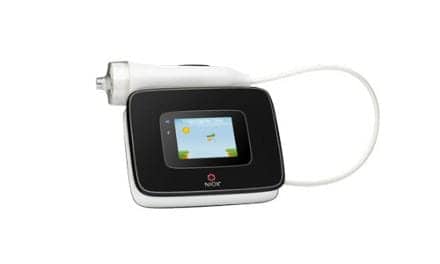AirLogix provides patients with the knowledge they need to manage their health cost-effectively.
AirLogix provides patients with the knowledge they need to manage their health cost-effectively.

The concept of disease management has been around for more than a decade, according to Susan Riley Earl, CEO of Dallas-based AirLogix. Disease management programs can range from simple mailings of educational materials to more all-inclusive services where staff members go into patients’ homes and educate them in their own environment.
AirLogix has been specializing in chronic disease and health management since 1994 and provides the full spectrum of disease management services. The company’s particular focus is on chronic obstructive pulmonary disease (COPD) and asthma, a respiratory disease that affects 17.3 million people in America and is steadily on the rise. There are more than 5,600 asthma deaths reported each year and more than 1 million hospitalizations annually. Those figures are especially appalling considering that asthma can be reversible, Earl says.
“In many people asthma is chronic, but in other cases where the triggers are eliminated, the patient may not continue to have the problem. And children sometimes simply grow out of being symptomatic,” she says.
“AirLogix has targeted asthma because of the sheer numbers suffering from the disease and the large portion of those that are children,” she says. Asthma is the most common chronic disease of childhood, affecting 5.3 million children under age 18.
“Kids as well as adults can manage their asthma, and we want to make kids healthy,” she says. “There are a tremendous number of work days and school days lost due to asthma. That has an impact on society. Schools are paid according to the number of kids who show up daily. Though those are soft costs, they are also real costs.”
In fact, health care costs associated with asthma are estimated at more than $7.5 billion annually, with another $1 billion in lost productivity. Asthma results in 100 million days of restricted activity and more than 10 million missed school days each year.
AirLogix hopes to decrease utilization of emergency and urgent care facilities, number of hospitalizations and length of stay, and overall chronic disease-related costs with its Asthma Health Management Program. The program incorporates interrelated components of several other clinical publications, with the primary foundation being “Guidelines for the Diagnosis and Management of Asthma,” published by the National Institutes of Health. AirLogix’s asthma management educational materials won the 1998 National Health Information Award from the Health Information Resource Center.
“We believe a coordinated, proactive, disease-specific approach to these health concerns can accomplish improved quality of life while reducing health care costs,” Earl says.
The asthma program focuses on self-care therapies, education, and support for quality of life improvements, as well as ways to reduce complications and exacerbations, which can result in health care utilization.
“The basic concepts of disease management are assessment, risk identification, education, intervention, and outcome collection,” Earl says. “You are first providing assessment to identify patients at risk and those with the disease.”
AirLogix contracts with 15 nationwide health plans, and patients are identified through claim analysis. The physician is then contacted to let him know that the program is available to the patient. After the initial assessment, the team goes back to the physician with its findings.
“The focus is really on compliance with the treatment plan,” she says. “We are acting as an adjunct to the physician and what he’s trying to accomplish. Physicians are ever busier these days, handling more patients, and their resources are limited. We can offer the opportunity to carry the treatment plan for that patient beyond the office walls by going into the home and helping apply the plan to that very unique environment.”
The physician plays an integral role in determining the patient’s management plan, and then receives periodic updates and feedback by AirLogix.
“We want to transfer knowledge to customers and facilitate productive patient-provider interactions, thereby empowering individuals to manage their own health,” Earl says. The goal is to act as an extension of the physician’s practice by reinforcing the management plan and increasing patient compliance.
The next step is providing the patient with education on the disease itself, especially the symptoms and the triggers of an exacerbation. Asthma is most likely a result of genetic factors—about one-third of all those with asthma share the problem with another member of their immediate family. Likewise, a child is six times more likely to have asthma if both parents have a history of asthma.
Asthma-triggering substances run the gamut from well-known causes like dust, smoke, and animal allergies, to not-so-well-known triggers like aspirin, intense emotions, and cooking vapors. The list of triggers includes high ozone levels; traffic jams; emotions, especially fear and anger; crying or laughing too hard; household products like aerosol sprays; vapors from cleaning solutions and paint; smoke from cigarettes, pipes, or cigars, wood-burning stoves or fireplaces, and charcoal cooking; infections; colds, upper airway congestion, sinus drainage, and sore throat; and allergies to dogs, cats, birds, and hamsters, or insects such as cockroaches and dust mites. Certain foods and pollens also can trigger asthma attacks.
“Identifying what the triggers are can be problematic,” Earl says. “A lot of people don’t understand that things like houseplants are triggers, as are pets, bubble bath, and stuffed animals in their kids’ rooms. There are so many things that cause asthma to exacerbate that we do a room-by-room assessment to identify potential triggers.”
Earl concedes that some of the triggers are especially difficult to avoid, and says the program merely tries to get patients to agree to avoid items on a temporary basis.
“For example, if the dog is sleeping in their room at night, we bargain with them to let the dog sleep outside of the room 2 nights to see how they feel,” she says. “We are applying learning principles here and people become compliant when they get immediate gratification that what they’ve done has helped. They stay episode-free and that’s encouraging because they can immediately see in the way they feel the impact of those changes.
“We try to work as a partnership,” she says. “Some patients are very compliant and some aren’t, but we’re getting the information out there to help patients who really do want to be helped.”
Once it has covered the causes and triggers of asthma, the AirLogix program focuses on creating a plan for the individual patient to monitor their symptoms and their peak flow readings, as well as providing a plan for intervention.
“We then provide consistent and regular follow-up with the patient, making sure they understand the concept completely and are complying with the physician plan of care,” she says. “We also make sure that they are compliant with their medication and that they understand why that’s important.”
Getting patients to utilize the correct medication is another difficult aspect of the program. “There are two types of asthma medication—short-acting and long-acting—and many people rely too much on the short-acting medication,” Earl says.
Follow-up can help monitor use of the proper medication as well as compliance with the program. The frequency and focus of subsequent phone or in-home interaction are planned for each individual patient and based on algorithms, criteria, and a symptom assessment score that incorporates AirLogix’s member-care experience. Finally, there is collection of outcome information on a regular basis to show that improvement has occurred.
“Most true disease management programs address those outcomes and if they don’t, then they are not truly disease management programs,” Earl says. “Many other programs will not provide the full scope. AirLogix has cared for more than 150,000 people with asthma and no one else can touch that. We have a great deal of experience and outcome data in large populations.”
One of the parameters for judging the program is to review how it impacts the patient’s quality of life, which includes maintenance of normal social and physical activity levels, decrease in the number of missed work and school days, and achievement of positive patient satisfaction ratings.
“We have a 50% return rate on our patient satisfaction ratings and 100% of those are good, very good, or excellent,” Earl says. “The patients love this program. We never get complaints. It makes them feel more under control, and they appreciate that someone is taking the time to educate them and help them to learn.
“This program is empowering for patients, because it helps them see that there is something they can do to feel better, to feel healthy,” she says. “Physicians’ time is limited these days, so when we spend up to 2 hours with our patients, their families feel so supported because everyone understands.
“Disease management needs to move to overall health management with the focus shifting from the particular disease to the whole patient,” she says. “Ultimately, that’s what AirLogix is hoping to accomplish.” N
Liz Finch is a contributing writer for RT Magazine.










